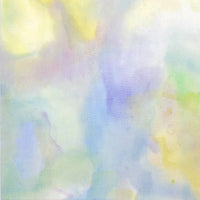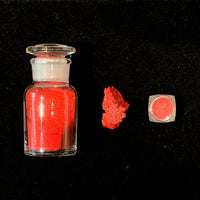Last Updated on : November 13th, 2025
Iwa-enogu, which means mineral pigment in Japanese, is an essential material for Japanese art and painting.
Although the origin of Iwa-enogu is not known, it is said that it came to Japan through mainland China during the Kofun period.
Iwa-enogu is a pigment made from ground minerals, and the manufacturing country varies depending on the color. For example, the raw material for Gunjo, the most symbolic blue color in Japanese art, is a mineral called azurite.
There is a historical record that azurite was obtained in Akita prefecture which used to have a copper mine, however today, most azurite is imported from overseas.
Although some people may think of ultramarine blue when they hear the color term "Gunjo," the natural ultramarine is made of lapis lazuli. Its original ore and color are different from the azurite blue.
Fun fact, colorants made from natural minerals have higher preservation qualities than the usual dyes. An ancient mural of women painted on the west wall of Takamatsuzuka Tomb between the 6th and 7th centuries shows how well-preserved the pigments and soot can be even today the colors remain vivid.
However, since Japan is an island nation with limited resources and is behind in technology, it was obliged to rely on imports for pigments. In "Nihonshoki (The Chronicles of Japan)," it is written that a monk named Damjing (Donchō in Japanese) was dispatched by the king of Goguryeo, a kingdom on the Korean peninsula, to work as a colorist and an ink-and-paper expert.
The mineral pigments are like colored sand, so to speak, and do not have fixing ability on their own. In other words, simply mixing the color in this jar with water does not make it paint. For mineral pigments, you need to mix them with animal glue or other binders to use them.
Compared to other colorants, mineral pigments have larger particles and are known for their rough and sandy-like texture.
Other than that, mineral pigments feel more materialistic compared to other pigments.
Contents Types and characteristics of mineral pigments
|
Types and characteristics of mineral pigments
These are the three main types:
・Natural Mineral Pigments (Tennen-iwa-enogu)
・Artificial Mineral Pigments (Shin-iwa-enogu)
・Kyojyo Mineral Pigments (Kyojyo-iwa-enogu)
As the name suggests, natural mineral pigments are ground minerals produced in mines. Since they are natural resources, the number of colors is more limited, in other words, they are unique because of their earthy color tones and sparkles that artificial pigments do not have.
On the other hand, Shin-iwa-enogu is a series of artificial mineral pigments. It has a variety of colors that natural mineral pigments cannot replace. To achieve a natural look like the natural mineral pigments, artificial mineral pigments are made by kneading pigments and lead-containing glass together, then firing them to create artificial mineral blocks and crushing them into pigment powder. Compared to natural mineral pigments, it does not reflect much light and has a matte appearance.
Kyojyo pigment is a type of artificial mineral pigment but it is made from lead-free glass.
Shin-iwa-enogu has reported that there is a chemical reaction that causes discoloration after mixing with sulfur, thus as a countermeasure, Kyojyo-iwa-enogu was developed in collaboration with the Kyoto Prefectural Technology Center for Small and Medium Enterprises and NAKAGAWA GOFUN ENOGU.
Since the Kyojyo series does not contain lead, it is environmentally friendly and possible to achieve darker tones, which is unique to this series because those colors do not exist in conventional artificial mineral pigments.
About the Labeling Numbers of Mineral Pigments
The following beautiful color gradation is due to the size differences of the particles created by grinding the ores and separating the pigments with water according to the particle sizes.
As you can see from the sample, although all the colors have the same names and are from the same mineral ores, the particles are separated and numbered into ten levels according to their sizes.
The lightest and finest pigment size is called "Byaku," also labeled as 白, which means white in Japanese, while the darkest and roughest particles are labeled as No. 5.
As the particles become finer, the amount of light-reflecting particles increases, thus the color appears brighter.
On the other hand, as the particles become rougher, light is diffusely reflected, resulting in a sparkling texture.
How to Use Mineral Pigments
Here are the painting materials that you need to use the mineral pigments.
①Boil the animal glue jar in hot water and pour the amount you need into another container.

②Place the mineral pigments on a ceramic plate by using a dispensing spoon.

③Use a glue spoon to add animal glue to the plate. You may adjust the amount of glue according to the coarseness of the mineral pigments.

④Knead them together thoroughly with your fingers.

⑤Add some water to the mixture and you’re good to go.
As with animal glue, please adjust the amount of water according to the coarseness of mineral pigments.
This time, I decided to add a little more water than animal glue.

⑥After kneading them well together, they are ready to be used.

About Animal Glue, a Painting Medium for Mineral Pigments.
In Japanese painting, a type of animal glue called "Sansenbon" is commonly used as a binder. However, this "Sansenbon" does not indicate a specific standard, so its quality and shape have varied over time.
In PIGMENT TOKYO, we carry various kinds of animal glue such as cow, deer, and fish, including the OX glue liquid 20% concentrated.
I recommend you try finding the right one that best suits your painting style.
Here’s an introductory guide for beginners, please check the video below for more.
Other Methods
This is a question frequently asked by our customers such as “Is animal glue the only binder for mineral pigments?”
In recent years, some artists choose synthetically made resin instead of animal glue for their artworks. Therefore, there isn’t any rule that you must use animal glue with mineral pigments.
However, if you want to maximize the unique texture of the crushed minerals, using animal glue is recommended because it does not adhere as strongly as synthetic resins and creates a subtle luster.
Conclusion
For those who would like to try Japanese art with Iwa-enogu right away, this set is a great choice.
Even if you do not know what to draw, there are sets you can enjoy painting like coloring books, such as the "Let's Enjoy Japanese Painting" set or the "Beginners Kit " produced by NAKAGAWA GOFUN ENOGU company.
Let's Enjoy Japanese Painting Set & Beginners' Kit
Some of you might think that boiling animal glue in hot water may seem a little challenging, but once you get used to it, you can easily use it and paint it with mineral pigments.
Therefore, why not take the first step by trying our beautiful mineral pigments?








